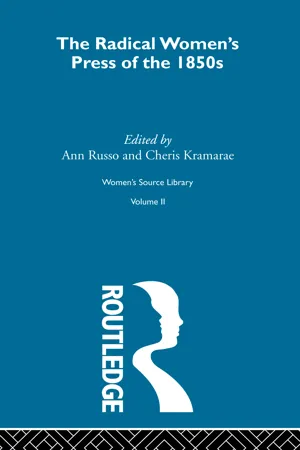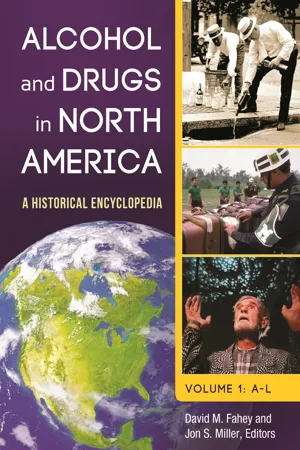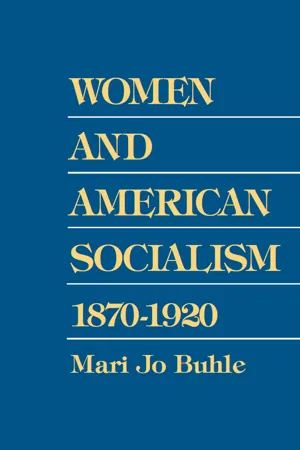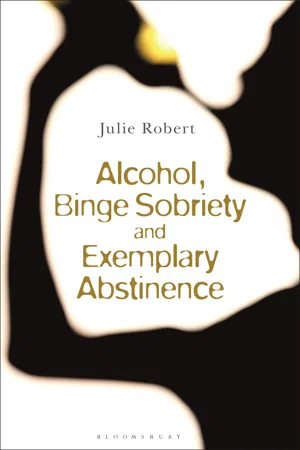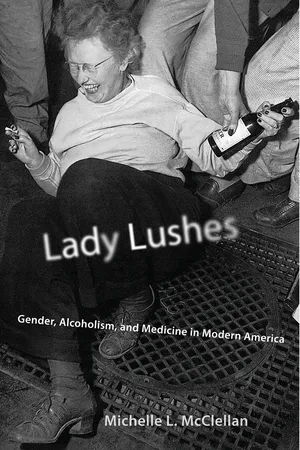History
Women's Temperance Movement
The Women's Temperance Movement was a social and political campaign in the late 19th and early 20th centuries, primarily in the United States and Canada, advocating for the prohibition of alcohol. Led by women, the movement sought to address the negative social and economic effects of alcohol abuse on families and society, and it played a significant role in the eventual passage of Prohibition laws.
Written by Perlego with AI-assistance
Related key terms
Related key terms
1 of 4
Related key terms
1 of 3
10 Key excerpts on "Women's Temperance Movement"
- eBook - ePub
- Immanuel Ness(Author)
- 2015(Publication Date)
- Routledge(Publisher)
As early as 1818, women's names had begun appearing on petitions opposed to the granting of tavern licenses. The American Temperance Society, founded in 1826, was the first voluntary association of any kind to attract large numbers of women from across the country. Women felt relatively comfortable participating in early temperance work because of its tactical focus on informal persuasion rather than political action. They distributed propaganda, ran temperance hotels, and attempted to persuade the men in their community to abandon alcohol. Although most women joined male-run societies, by the end of the decade women had begun to form their own independent organizations; twenty-four independent female temperance societies existed by 1831.With the emergence of the Daughters of Temperance, sister organization to the Sons of Temperance, women were finally provided with a leadership vehicle within the temperance movement. The Daughters attracted large numbers of female activists, reaching their peak membership of 30,000 members in 1848. The association connected local auxiliaries and supported women's interest in the movement through the New York Olive Plant, the first temperance newsletter to be edited by women. Following the Maine Law crusades of the early 1850s, which sought to end alcohol consumption in that state through legislative means, women expanded their activism to include petitioning for temperance laws and canvassing voters in the North and South. Although they had little impact on the movement, a few scattered incidents of female vigilantism against saloons appeared during this period.As women sought to broaden their role in the temperance movement, they forced issues of women's rights to the forefront of the movement. Many male temperance workers resisted the expansion of women's roles, fearing that the movement would lose respectability and momentum. When the leaders of the Sons of Temperance refused to allow women to participate equally in their 1852 convention, prominent women's rights advocates, including Susan B. Anthony, Elizabeth Cady Stanton, and Amelia Bloomer, walked out and formed the Woman's State Temperance Society of New York. However, independent female organizations only lasted a few years as many activists shifted their focus to women's rights. Although women would come to dominate the movement in the post-Civil War era, by the 1860s the sex-integrated Templars remained as the only significant organization to support women's temperance work. - eBook - ePub
The Radical Women's Press of the 1850's
Radical Women's Press of the 1850s
- Cheris Kramarae, Ann Russo(Authors)
- 2013(Publication Date)
- Routledge(Publisher)
9 Organizing for Social ChangeThe woman’s rights movement of the 1850s cannot be understood apart from the other major social reform movements of the day: the temperance, abolition, labor, health and dress reform movements as well as women’s moral reform and benevolent organizations which organized around poverty, prostitution and criminality.Many white middle-class women had been active for years in a variety of organizations directed towards social reform. Because their work inevitably brought them into contact with the problems, restrictions and tragedies in women’s lives, they developed specific perspectives on social issues grounded in a growing knowledge of women’s oppression, and the centrality of that oppression to other social issues. Throughout the 1850s, in the woman’s rights journals, women defined and debated the importance for women to build themselves into a collective entity (see “Strength in Unity”) and to be a political force with a unique perspective and role to play in social reform (see also section 8). Sometimes they argued that women’s power derived from their special relationship with morality, while others argued that, regardless of morality, women were potentially a distinct political grouping with their own interests at stake (see “Women! Organize for Women”).Women had been active in the temperance movement since the 1830s in large numbers, and the temperance reformers looked to women as central participants in reform within the home; because the devastating effects of intemperance could most clearly be seen on women and their children, many women could identify with the need for change. The centrality of women to temperance reform, however, did not translate into women’s power to help direct and lead the movement; women activists continually came face to face with women’s powerlessness. Woman’s rights activism emanated naturally from women’s participation in the temperance movement, both in terms of the particular impact of intemperance on women’s lives and women’s lack of power to equally participate in temperance reform or in public policy (see “Work First for Power, Then Temperance”). - eBook - ePub
- Kenneth D Rose(Author)
- 1995(Publication Date)
- NYU Press(Publisher)
12A genuine civic alarm that intemperance was threatening the foundations of the young republic led to the formation of the first great American temperance societies, but there were many other reasons for temperance activism. The increasing need for employers to maintain a sober work force, the proselytizing morality that emerged from the Second Great Awakening, and the aspirations of a redefined middle class that increasingly saw the consumption of alcohol as inappropriate were all elements of the temperance impulse. For women the stakes were especially high. As late as 1850 wife beating “with a reasonable instrument” was legal in nearly every state, with the consequence that if a woman found herself saddled with a drunken, abusive husband, she had few legal options with which to protect herself (ills. 1 and 2).13 In 1821, for instance, Margaret Ramsay applied for a divorce in Tennessee, testifying that her husband whipped her during bouts of drunkenness, held a knife to her throat, brought prostitutes into the house (and contracted venereal disease from one of them), provided her with only one dress, and would not allow her to visit her friends. Ramsay’s divorce petition was denied.14 Such horrifying circumstances led some temperance reformers, including Elizabeth Cady Stanton, to advocate liberalized divorce laws as part of their antidrink programs.15The earliest antebellum temperance organizations often excluded women from membership because of a pervasive belief that public female participation in the temperance debate was not seemly and that women could best advance the cause of temperance by exercising “moral suasion” at home. This idea, that woman was endowed with unique moral qualities and that the application of her moral goodness could produce a decisive influence from within the domestic realm, put a premium on womanly responsibilities that included the maintenance of a temperate home environment. The temperate home quickly became the cornerstone of home protection. By 1841 Catharine Beecher was proclaiming, “Intemperance in drink has produced more guilt, misery, and crime, than any other one cause. And the responsibilities of a woman, in this particular, are very great; for the habits and liabilities of those under her care will very much depend on her opinions and practice.”16 A decade later, as increasing numbers of women were involving themselves in social purity movements, Mary C. Vaughan, president of the Daughters of Temperance, insisted, “There is no reform in which woman can act better or more appropriately than temperance.”17 - eBook - ePub
Alcohol and Drugs in North America
A Historical Encyclopedia [2 volumes]
- David M. Fahey, Jon S. Miller, David M. Fahey, Jon S. Miller(Authors)
- 2013(Publication Date)
- ABC-CLIO(Publisher)
Female temperance advocates played a prominent role throughout the quest for prohibition in the United States. Women such as Frances Willard and Carry Nation became the most well-known temperance crusaders. With their critique of alcoholic beverages centered on damage to women, children, and family life caused by male drinking, organizations such as the Woman’s Christian Temperance Union (WCTU) fostered the impression that women were united in their opposition to alcoholic beverages. Following simultaneous campaigns for National Prohibition and women’s suffrage amendments in which support for these reforms was often linked, the adoption of both constitutional provisions within 18 months of one another reinforced the view that women naturally favored a liquor ban.Women, however, had never been universally hostile to alcoholic beverages. In the late 19th century, many saloons featured a separate “ladies entrance,” and women were primary consumers of high-alcohol patent medicines. For instance, “Lydia Pinkham’s Vegetable Compound,” a popular tonic, contained 20 percent alcohol. More important, gender distinctions in alcohol use began to disappear as it became more common for men and women to drink wine and cocktails together at gatherings in middle-class homes. With the arrival of Prohibition and the closing of male-oriented saloons, drinking shifted toward mixed-sex speakeasies and particularly toward the home, where in some circumstances alcohol use remained legal, and where in any case Volstead Act enforcement did not intrude. In a domestic environment where alcoholic beverages were becoming more familiar and were largely being used moderately, female doubts about Prohibition increased.The WONPR emerged in the late 1920s from discussions among upper-class women concerned with the impact of National Prohibition upon social stability and regard for law. These women had come to perceive federal and state efforts to enforce National Prohibition as both heavy-handed and ineffective. Even though overall alcohol consumption may have declined compared to its pre-Prohibition level, their attention, as well as that of the general public, focused on highly visible violations of the “dry law.” Public discussion began to shift from the matter of alcohol abuse to concerns about declining respect for law and government. - Holly Berkley Fletcher(Author)
- 2007(Publication Date)
- Routledge(Publisher)
Stone’s words also highlight the intersections between the antebellum reform cultures of temperance, abolition, and women’s rights. Within the temperance movement, the influence of the latter two reforms proved to be incredibly divisive. This was the case on both an ideological level, as racial and gender equality countered patriarchal assumptions, and on a practical level, as the American Temperance Union tried to maintain national unity as the Civil War drew near. An examination of the feminist and abolitionist employment of temperance illuminates how temperance became an arena for debating the gendered and racial structures of society and how the movement was embroiled in the emerging divide between North and South. In this political climate, the icon of the self-made man became a lightning rod for conflict instead of a unifying symbol.The ways in which temperance fit within this larger dialogue also demonstrates the diversity and elasticity of temperance ideology. In other words, different groups and individuals conceived of temperance in different ways and to different ends. Even taken as an insular reform, temperance was no singular movement of white, middle-class men. The working-class Washingtonian movement comprised a notable departure from the mainstream. In particular, the Washingtonians demonstrated new ways of thinking about gender roles and definitions within the context of temperance. Although there is no evidence that the Washingtonians directly influenced or contributed to the brewing conflict over gender and racial equality, within temperance and without, they subtly subverted the culture of the self-made man and illuminated the complexities of temperance discourse.Historians have documented well the roots of the Washingtonian movement in the late 1830’s, when the temperance movement, as well as the American economy, entered a period of decline. Disputes over the extent of teetotalism and the use of legislative action were partly to blame. In addition, the dire economic situation resulting from the Panic of 1837 depleted the American Temperance Union’s coffers.2 It was at this point, in 1840, that six working-class Baltimore alcoholics pledged to each other they would quit drinking. With unemployment on the rise, they viewed it as a practical step toward greater personal security and never intended to begin a mass movement of abstinence among working-class men and women. Within six months, however, twenty thousand people formed fifty new “Washingtonian” temperance societies, injecting the temperance movement as a whole with new life—and infusing it with new ideas and directions that challenged the iconography of the self-made man.3- eBook - ePub
- Mari Jo Buhle(Author)
- 2023(Publication Date)
- University of Illinois Press(Publisher)
While an awareness of changing labor patterns and familial roles inspired urban activists to urge woman’s advancement into civil society and to insist upon her right to meaningful labor, a growing dissatisfaction felt intensely in rural and small-town America called legions of women to attention. Industrial and urban growth might offer women either new opportunities or hardships, and activists sought to meet both contingencies. But the relative decline of the countryside in economic power and political prestige seemingly threatened to plunge the republic into chaos and to eclipse the progress of their sex at the very center of American civilization. Following the Panic of 1873, which fell heavily on small towns and rural areas, women found their own distinctive form of mobilization—the temperance crusade.For thousands of women temperance as a fighting slogan gave coherence to long-standing grievances. By lashing out at symbols of men’s abuse of power such as public drunkenness and political corruption stemming from the saloons, women helped to create a climate for a massive protest movement in the western states. Small-town and rural women also delineated a social critique and prescription for reform congruent with that of their urban sisters: to free themselves and to save the nation, women required the power only economic and political equality could bestow; to attain that power, women required a far-reaching sisterhood capable of overcoming all obstacles. Here especially the call for woman suffrage gained a new constituency and a new purpose. Not for abstractions alone did rural women demand the ballot but in order to bring womanly authority to bear upon a wicked world.The western woman’s movement grew from an outbreak of temperance evangelism beginning in the late 1860s and escalating significantly during the hard winter of 1873 and 1874. Through songs, prayers, scripture readings, and mass assemblies, women closed saloons in town after town across the Midwest. Within a year temperance agitation had spread so quickly, the pace of women’s activities so dramatically, that the cause became known as the woman’s revolution. In November, 1874, over 200 women representing organizations in seventeen states met to form the National Woman’s Christian Temperance Union.20Much like the urban activists, the most prescient leaders of the WCTU addressed from their first moment of involvement questions of women’s social and political status. Because they perceived the saloon as a direct challenge to the sanctity of women’s domain, the home, they reasoned that women must be enabled to protect their sacred trust by participating freely in civic life. Thus a resolution passed at the first WCTU convention stated boldly that “much of the evil by which this country is cursed comes from the fact that men in power whose duty is to make and administer the laws” had failed.21 Among the ranks the seeds of protest had already fallen upon fertile ground. As one self-styled “Private Dalzell” of the temperance army announced in 1874, “the seal of silence is removed from Woman’s lips by this crusade, and can never be replaced.”22 - eBook - ePub
- Edith S Gomberg(Author)
- 2019(Publication Date)
- Routledge(Publisher)
The New Temperance Movement: Through the Looking-Glass Dwight B. Heath, PhDSUMMARY . A long-term rise in drinking by Americans slowed in the 1970s and then reversed; several interest-groups pressed for higher taxes on alcohol, server-liability, severe penalties for drunk-drivers, a higher purchase-age, and many other legislative and regulatory restrictions. Several similar changes are occurring in other countries. A quasi-scientific rationale for reducing alcohol consumption links quantity directly to a wide range of social and individual problems, although the correlation often varies, both crossculturally and over time in the U.S. The new temperance movement holds out the false promise of a quick and easy solution to drinking problems, and provides a socially acceptable outlet that allows people to blame alcohol and wrongdoers in a Neo-Victorian complacency.In any discussion about current controversies in the drug field, one of the most pervasive and visible ones has to do with increasing pressures to reduce the consumption of alcoholic beverages among all populations. Ironically, it is also a controversy that is perceived as such by few other than those who have taken a strong stand on one side or the other. Many of the principal spokespersons are academicians and other scientists whose writings often are scrupulously phrased in order to minimize controversy, and much that is written on the subject is interpreted as scientifically based and, therefore, straightforward and objective. Besides which, who could be so hard-hearted as to take issue with the World Health Organization’s prescriptions for achieving “Health for all in the year 2000”? Unfortunately, much of what is said along these lines constitutes what many refer to as “the new temperance movement,” and it has more to do with politics and emotion than it does with science. - eBook - ePub
- Julie Robert(Author)
- 2022(Publication Date)
- Bloomsbury Academic(Publisher)
The apprehension about unflattering associations notwithstanding, TSIs have largely taken these earlier temperance movements as normative examples. They have capitalized on many of their legacies, including their international philanthropic networks, their mustering of both medical and economic arguments, the utility of public commitments and even some of their lesser-known forms of involvement (such as time-delimited initial commitments) to create popular campaigns. The origins, rationales, forms, discourses and even exemplifying practices of temperance have nonetheless been reimagined and made palatable to contemporary audiences in a way that ‘temperance’ as popularly understood could not be.Temperate values on display
Temperance, as Gusfield (1986) established, is often framed as a response, admittedly a symbolic one, to a ‘moral panic’ (Cohen 2002) about alcohol consumption. This is to say that temperance was a reaction to the popular perception that alcohol was a problem that was worsening and that would continue to worsen without intervention. Analyses of both temperance and neo-temperance contexts reveal that in objective terms, alcohol consumption prior to the initiation of renewed calls for regulation and prohibition was in decline (Hunt 1999; Reinarman 1988). Images of alcoholic excess and sensationalist headlines – whether the gin drinking of nineteenth-century working-class England or the binge drinking of young women and ‘alcohol-fuelled violence’ that began to claim the attention of modern news outlets in Britain in 2004 (Berridge 2013) and Australia in 2008 (Azar et al. 2013) – nonetheless presented alcohol as an emergent threat to social order rather than as practices whose effects were mostly felt by individuals, most often individuals who were virtually unknown to the advocates of temperance. The order in question, albeit in different ways, relied upon self-governance as a means of distinction and differentiation. Temperance activities (both old and new), as Levine (1978) influentially argued, were accordingly predicated on the overt manifestation of restraint and responsibility as the symbolic solution to the perceived problem of rampant alcohol consumption. - eBook - ePub
- Michelle L. McClellan(Author)
- 2017(Publication Date)
- Rutgers University Press(Publisher)
Very little reliable research was conducted during the 1920s on the effects of Prohibition, 102 leaving historians to piece together fragmented, indirect, and unreliable evidence. Despite these challenges, scholars have determined that Americans’ per capita alcohol consumption fell during the 1920s—contrary to many contemporary observations. Historians writing recently have concluded that women, like all groups, drank less during Prohibition simply because alcohol was less accessible. 103 But if the promise of Prohibition had been to eliminate drinking and all the problems that went along with it, then reduction was not enough. Furthermore, the Great Depression brought an economic argument for repeal: If the government could tax liquor once again, much-needed revenue would be provided without an extra burden of direct taxation. Finally, some business and civic leaders who had supported temperance became increasingly concerned about the extension of federal power that Prohibition represented. By the later 1920s, many individuals and groups began to mobilize for the unprecedented task of repealing a constitutional amendment. 104 As in the temperance crusade, women—and ideas about women’s proper roles—played important parts in assessments of Prohibition and in the campaign for repeal. Press coverage, some of which came from self-consciously sophisticated female journalists who may well have sought to normalize their own drinking habits, 105 insisted that women were drinking more than ever before and catching up with men. “Deplore it if you will,” one writer declared, “the number of men who drink is scarcely in excess of the number of women.” 106 Women’s involvement in the repeal campaign was also shocking to many - eBook - ePub
Music and Performance Culture in Nineteenth-Century Britain
Essays in Honour of Nicholas Temperley
- Bennett Zon(Author)
- 2016(Publication Date)
- Routledge(Publisher)
Initially, like many Victorian moral reform movements, members of the middle and upper classes led temperance as paternalistic reform (starting from 1815). This early temperance focused on moderation, recommending that the working classes drink beer rather than stronger spirits, such as gin. By mid-century, however, temperance was linked explicitly with religion. Temperance workers used many of the same strategies as Evangelical religionists, such as home visits, praise services, etc. to promote temperance throughout England. At the same time, the tactics of the temperance movement switched from condoning moderation to agitating for complete and total abstinence. This can be seen throughout the century via the increasing use of the word ‘teetotaler’ to describe individuals who abstained from alcohol over the word ‘temperate’. 6 The political conversation around temperance also shifted from reforming the individual to saving the entire society, via both moral suasion and, increasingly, regulation banning the sale of alcoholic beverages during certain times or in certain places. 5 The best histories of Victorian English temperance remain Lilian Lewis Shiman’s Crusade against Drink in Victorian England (New York: St. Martin’s Press, 1988) and Brian Harrison’s Drink and the Victorians: The Temperance Question in England, 1815–1872 (London: Faber and Faber; Pittsburgh: University of Pittsburgh Press, 1971). A shorter introduction can be found in Rebecca Smith’s The Temperance Movement and Class Struggle in Victorian England (Chicago: Loyola University, 1993 [ http://www.loyno. edu/~history/journal/1992–3/smith-r.htm, accessed 9 June 2011]. 6 The origins of the word teetotaler – supposedly coined in the 1830s by the Preston Temperance Society – show that even in the early years of the English temperance movement, many thought moderation in drink was not enough
Index pages curate the most relevant extracts from our library of academic textbooks. They’ve been created using an in-house natural language model (NLM), each adding context and meaning to key research topics.
Explore more topic indexes
Explore more topic indexes
1 of 6
Explore more topic indexes
1 of 4

